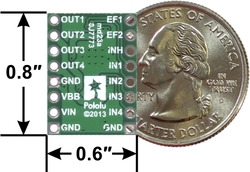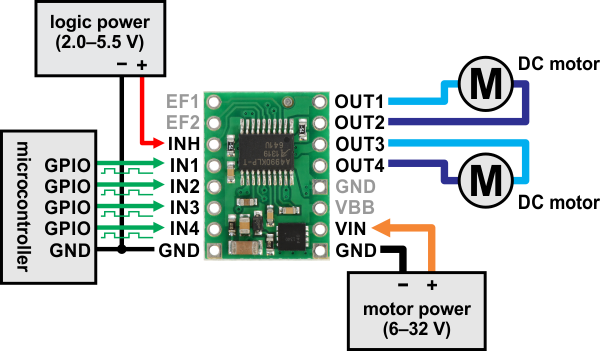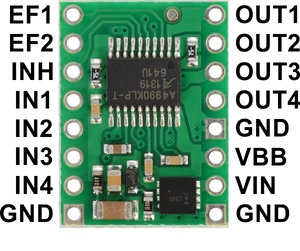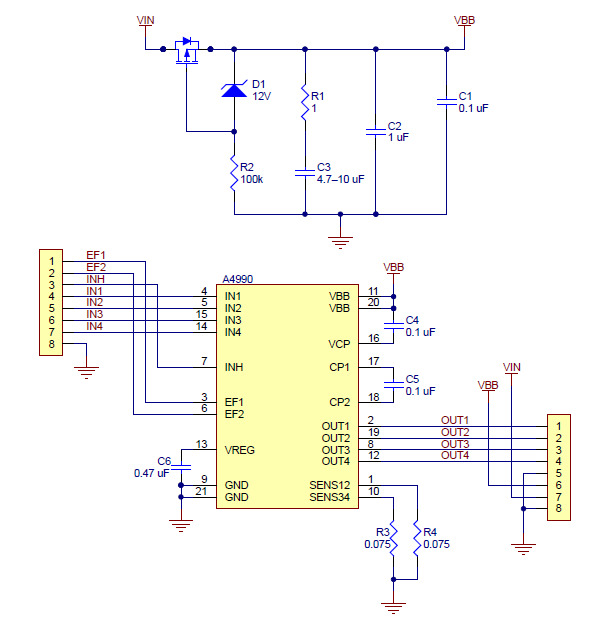

A4990 Dual Motor Driver Carrier
This compact breakout board makes it easy to use Allegro’s A4990 dual motor driver, which can control two bidirectional DC motors over a wide operating voltage range of 6 to 32 V. It is capable of delivering a continuous 0.7 A to each motor channel, and onboard sense resistors enable the A4990 to limit the peak motor current to about 0.9 A per channel. The driver also features protection against reverse-voltage, under-voltage, over-voltage, over-current, and over-temperature.
 |
| A4990 dual motor driver carrier, bottom view with dimensions. |
|---|
Allegro’s A4990 is a dual H-bridge motor driver IC that can be used for bidirectional control of two brushed DC motors at 6 to 32 V. It can supply up to 0.7 A continuously to each motor channel, and the current control feature of the A4990 limits the peak motor current to about 0.9 A per channel with the onboard sense resistors, making this a good choice for small, low-current motors that run on relatively high voltages. Since this board is a carrier for the A4990, we recommend careful reading of the A4990 datasheet (301k pdf). The board ships populated with all of its SMD components, including the A4990 and an additional FET for reverse battery protection.
For a single-channel driver with a DIR/PWM interface and a similar operating voltage range, please consider our DRV8801 carrier. For lower-voltage alternatives to the A4990, consider our DRV8833 and DRV8835 dual motor driver carriers.
1 The overvoltage protection typically kicks in at 34 V, but it can trigger at voltages as low as 32 V.
2 While the A4990 can tolerate input voltages as high as 50 V, the reverse-voltage protection MOSFET is only rated for 40 V.
 |
| Minimal wiring diagram for connecting a microcontroller to an A4990 dual motor driver carrier. |
|---|
In a typical application, power connections are made on one side of the board and control connections are made on the other. The INH (inhibit) pin is pulled low internally, disabling the A4990 by default, and must be driven high (2.0–5.5 V) in order to enable the driver.
The OUT1 and OUT2 pins form one motor channel while the OUT3 and OUT4 pins form the other. The state of each output is controlled by a corresponding input (IN1 through IN4); note that IN2 and IN4 are inverted inputs. All four INx pins are pulled to their inactive states by default. See the truth tables in the A4990 datasheet for more information on how the inputs affect the driver outputs.
The EF1 and EF2 pins are open-drain outputs that are driven low by the chip to indicate active faults (the datasheet describes what each combination of EF1 and EF2 means). Otherwise, these pins remain in a floating state, so you will need to connect external pull-up resistors (or use microcontroller inputs with their built-in pull-ups enabled) if you want to monitor fault conditions on the driver.
 |
| PIN | Default State | Description |
|---|---|---|
| VIN | 6–32 V motor power supply connection. | |
| VBB | This pin gives access to the motor power supply after the reverse-voltage protection MOSFET (see the board schematic below). It can be used to supply reverse-protected power to other components in the system. It is generally intended as an output, but it can also be used to supply board power. | |
| GND | Ground connection points for the motor and logic power supplies. The control source and the motor driver must share a common ground. | |
| OUT1 | Motor A output +. | |
| OUT2 | Motor A output â?’. | |
| OUT3 | Motor B output +. | |
| OUT4 | Motor B output â?’. | |
| IN1 | LOW | Control input for OUT1. PWM can be applied to this pin. |
| IN2 | HIGH | Inverted control input for OUT2. PWM can be applied to this pin. |
| IN3 | LOW | Control input for OUT3. PWM can be applied to this pin. |
| IN4 | HIGH | Inverted control input for OUT4. PWM can be applied to this pin. |
| INH | LOW | Logic input that puts the A4990 into a low-power sleep mode when low. |
| EF1 | floating | Error flag output 1: driven low to indicate active fault status; floating otherwise. |
| EF2 | floating | Error flag output 2: driven low to indicate active fault status; floating otherwise. |
The A4990 can actively limit the current through the motors by using a fixed-frequency PWM current regulation (current chopping). This carrier board connects 0.075 Ω resistors to the current sense pins, which sets the current limit to a nominal 1 A per channel. In our tests, the board actually limited the motor current to slightly above 0.9 A.
Even though the driver limits the motor current to about 0.9 A per channel, the chip by itself will overheat at lower currents. For example, in our tests at room temperature with no forced air flow, the chip was able to deliver 0.9 A per channel for approximately 20 s before the chip’s thermal protection kicked in. A continuous current of 0.7 A per channel was sustainable for many minutes without triggering a thermal shutdown. The actual current you can deliver will depend on how well you can keep the motor driver cool. The carrier’s printed circuit board is designed to draw heat out of the motor driver chip, but performance can be improved by adding a heat sink. Our tests were conducted at 100% duty cycle; PWMing the inputs will introduce additional heating proportional to the frequency (unless the A4990 is already PWMing the outputs to limit the current).
This product can get hot enough to burn you long before the chip overheats. Take care when handling this product and other components connected to it.
|
|
Two 1A—8-pin breakaway 0.1" male headers are included with the A4990 motor driver carrier, which can be soldered in to use the driver with perfboards, breadboards, or 0.1" female connectors. (The headers might ship as a single 1A—16 piece that can be broken in half.) When used with these header pins, the board can be oriented with the parts visible, as shown in the right picture above, or with the silkscreen visible, by soldering the headers in from the opposite side. You can also solder your motor leads and other connections directly to the board.
 |
| A4990 Dual Motor Driver Carrier schematic diagram. |
|---|
Cechy
Producent BTC Korporacja sp. z o. o. Lwowska 5 05-120 Legionowo Polska sprzedaz@kamami.pl 22 767 36 20
Osoba odpowiedzialna BTC Korporacja sp. z o. o. Lwowska 5 05-120 Legionowo Polska sprzedaz@kamami.pl 22 767 36 20
Podwójny sterownik silników DC przeznaczony dla Raspberry Pi, który umożliwia zasilanie silnika napięciem w zakresie 4,5-28V i poborze prądu przy pracy ciągłej 2,6A (5A w szczycie) dwóch silników DC. Zestaw do samodzielnego montażu. Pololu 2761
Nakładka przeznaczona do użycia z płytkimi z serii Feather zawiera dwa układy TB6612 pozwalające na sterowanie silnikami prądu stałego lub silnikami krokowymi. Do komunikacji z nakładką wykorzystywany jest interfejs I2C. Adafruit 2927
Sterownik silnika krokowego z układem MP6500, pozwala na zasilanie silnika bipolarnego prądem do 2A na fazę, bez użycia radiatora. Układ może być zasilany napięciem w zakresie 4,5...35V. Pololu 2969
Podwójny sterownik silników pozwalający na sterowanie dwóch silników DC napięciem 2,7-10,8V i prądem ciągłym 1,2A na kanał. Pololu 2130
Brak towaru
Wysokoprądowy sterownik silnika DC 24v12 umożliwia sterowanie silnikiem DC w systemach do 40 V przy zachowaniu kompaktowych wymiarów i prostego interfejsu PWM/DIR. Moduł sprawdza się w napędach robotów i urządzeń mobilnych wymagających prądu do 12 A bez radiatora, przy możliwości zwiększenia wydajności prądowej przez dodatkowe chłodzenie i odpowiednie filtrowanie zasilania. Pololu 757
Pololu G2 24v21 to miniaturowy sterownik silnika DC. Zasilanie sterownika: 6.5V...40V. Wydajność prądowa modułu: 21A.
Moduł posiada zabezpieczenie przed napięciem wstecznym i przepięciami. Pololu 2995
Moduł sterownika silnika krokowego DRV8825 dla Arduino. Pozwala na sterowanie dwoma napędami, wyposażony w złącze XBee. DFRobot DRI0023
Sterownik silnika BLDC oparty na układzie Allegro A89301 umożliwia bezczujnikowe sterowanie w szerokim zakresie napięcia od 5,5 V do 48 V i prądem fazowym do 11 A bez dodatkowego chłodzenia. Obsługuje cztery tryby sterowania: napięciem analogowym, sygnałem PWM, częstotliwością impulsów oraz przez interfejs I²C z możliwością konfiguracji parametrów i zapisu ustawień w pamięci EEPROM. Dzięki algorytmowi Field-Oriented Control (FOC) zapewnia cichą i wydajną pracę, a wbudowane zabezpieczenia chronią układ przed zwarciem, odwrotną polaryzacją i zbyt niskim napięciem. Pololu 5357
Brak towaru
Kompaktowy moduł rozszerzeń kompatybilny ze sterownikami silników krokowych DRV8825 i A4988. Umożliwia wpięcie płytki ze sterownikiem i wygodne podłączenie pozostałych elementów systemu
Brak towaru
Zestaw składający się z modułu sterownika silnika krokowego opartego na układzie ULN2003 oraz silnika krokowego zasilanego napięciem 5V.
Brak towaru
Jednokanałowy sterownik silnika DC, który może kontrolować ruch napędu o napięciu zasilania do 36 V i poborze prądu do 15 A. Sterowany za pomocą sygnału PWM. DFRobot DRI0042
Niewielka płytka z sterownikiem silnika szczotkowego DRV8838 działającym w napięciach od 0 V do 11 V i prądzie ciągłym 1,7 A (1,8 A chwilowym). Pololu 2990
Sterownik silników krokowych, oferujący mikroki aż do 1/256 kroku, co zapewnia wyjątkową precyzję i płynność ruchu. Dzięki prostej obsłudze – wymagającej jedynie dwóch pinów z mikrokontrolera – oraz niskim napięciu pracy (1,8 do 10 V), doskonale nadaje się do energooszczędnych aplikacji mobilnych, robotycznych i DIY. Zintegrowane złącza, diody LED i potencjometr do regulacji prądu ułatwiają prototypowanie i bezpieczną integrację z popularnymi platformami takimi jak Arduino czy ESP32. Adafruit 6353
Kompaktowy sterownik silnika krokowego z układem TMC2208 o napięciu pracy od 4 do 35 V. Oferuje płynną, cichą pracę, wysoką wydajność, różnorodne tryby pracy oraz łatwą konfigurację. Jest sterowany przez interfejs STEP/DIR i stanowi idealne rozwiązanie dla drukarek 3D oraz podobnych zastosowań
Sterownik silnika prądu stałego (DC) o napięciu pracy 6-34V i maksymalnym prądzie ciągłym 30A. Posiada możliwość łatwej realizacji pętli sprzężenia zwrotnego oraz liczne systemy bezpieczeństwa. Pololu 3290
Brak towaru
Podwójny sterownik silników pozwalający na wysterowanie dwóch silników DC napięciem od 4,5 do 13,5V i prądem ciągłym 1,2 A na kanał. SparkFun ROB-14451

A4990 Dual Motor Driver Carrier
